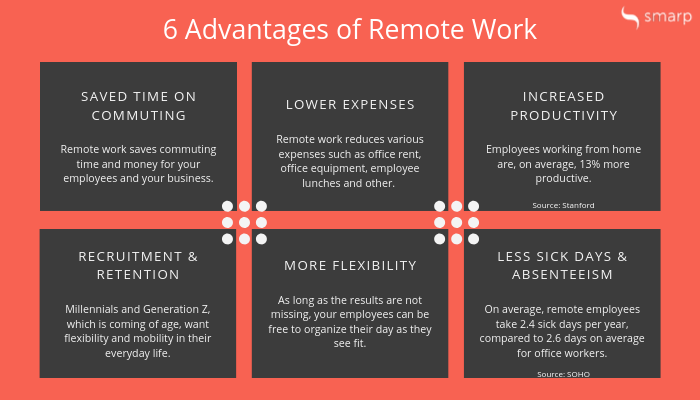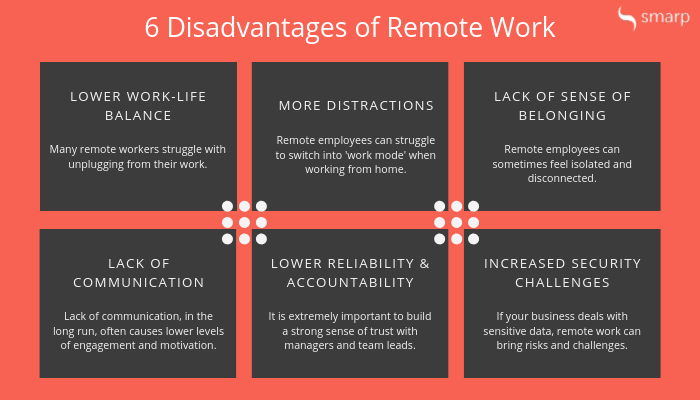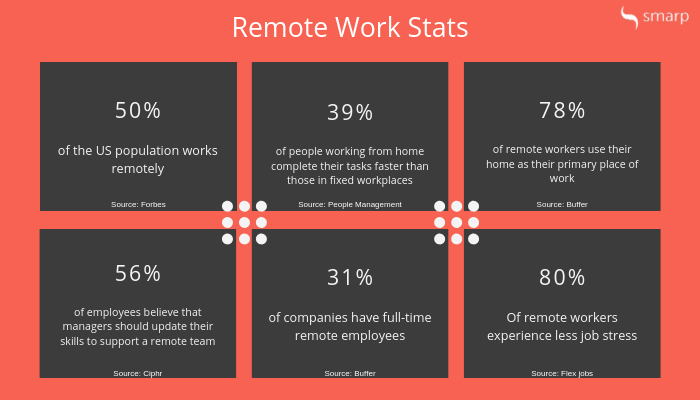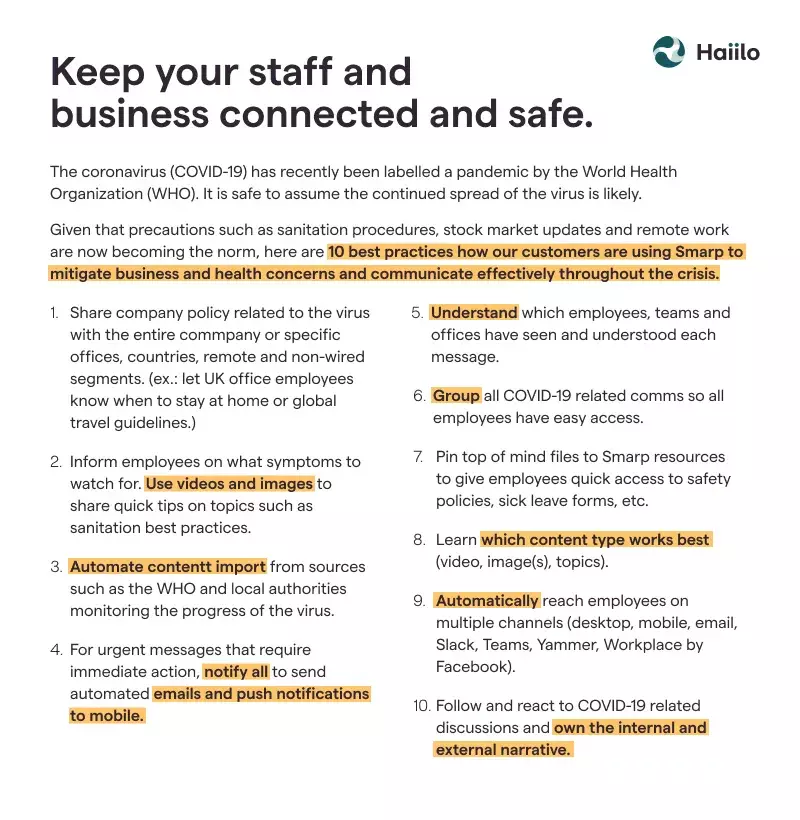The pandemic is completely redefining the way teams communicate and work. While remote work used to be offered by some companies as a way to offer a more flexible lifestyle to their employees, it has now become the norm for most businesses.
Remote work is not an option or a privilege any more. It has become the norm in most organizations right after the World Health Organization (WHO) announced that COVID-19 reached the pandemic status and urged Governments and other authorities to step in to prevent the virus from spreading.
🔎 Here’s an overview of the topics we’re covering in the blog post:
Remote Work Is Becoming the New Norm
Top Best Practices for Managing a Remote Team
2020 Marks the Abrupt Shift to Remote Work
Communication Challenges with Remote Employees
Build Strong Connections With Your Remote Teams With Haiilo
Remote Work Is Becoming the New Norm
The pandemic is revolutionizing the workplace. Teams are completely changing the way they are communicating and working.
It is hard to estimate the number of companies that have embraced remote work since the beginning of the crisis, but Gartner experts share some clues in one of their latest surveys.
The team has surveyed 800 global HR executives last month and found that 88% of organizations have encouraged or required employees to work from home, regardless of whether or not they showed coronavirus-related symptoms.
Read on: Coronavirus: Why Your Internal Communication Is More Important Than Ever
Remote work is drastically changing the way employees interact with the rest of the team and their managers.
To help employees maintain their productivity levels and not feel disconnected, businesses set up additional virtual check-ins for employees with managers and introduce new tools for virtual meetings.
Indeed, keeping business running as smoothly as possible is the priority number one for most — if not all — managers. But are these actions enough to avoid business disruptions during the crisis?
The thing is, employees are now working from home full time until further notice.
What’s more, this new way of working got implemented without any transition, which makes remote work extremely challenging for both companies and employees.
Read on: Crisis Communication — How to Communicate with Your Employees During a Crisis?
These days are particularly hectic and challenging. To help you communicate and engage with your remote employees during the pandemic, we’ve gathered 20 best practices for making remote work for your teams.
Top Best Practices for Managing a Remote Team
If you want to help your employees feel connected and engaged, especially in times of crisis such as COVID-19, follow these 20 advice:
1. Give employees a sense of belonging
A study by The Wall Street Journal suggests that one of the crucial factors that separates successful companies from others are those that give employees a sense of belonging.
The author, Sue Shellenbarger, states:
“Amid growing divisiveness and stridency in public life, a sense of belonging at the office will be increasingly prized by employees, and a crucial condition for fostering innovation.”
2. Define goals for remote workers
According to research, 39% of people working from home complete their tasks faster than those in fixed workplaces.
However, in order to set them up for success, employers have to set clear and measurable goals for their remote employees.
With remote teams – where communication is more challenging and things can get lost in translation – it’s important to be crystal clear about their duties and responsibilities.
3. Improve your overall internal communications strategy
If your overall communication strategy is unsuccessful, engaging your remote employees will be mission impossible.
Therefore, employers should put more effort into prioritizing employee relations and engagement efforts.
💡Extra resource: Learn about how to build a better company culture with internal communications.
4. Communicate regularly
Setting up periodic virtual or in-person all-company meetings is crucial to help everyone stay on the same page and understand core company values.
This is especially true for remote employees who do not have the opportunity to communicate with their co-workers in person on a daily basis.
5. Check in frequently and be proactive
As remote teams may feel disconnected, managers who lead remote teams need to make themselves available.
Frequent check-ins with remote workers are a great way to help them overcome challenges that come with remote work.
Waiting for an employee to speak up may be too late. In fact, many of them will never decide to raise a problem themselves.
Frequently ask a simple question such as “How can I help you be more productive and feel more connected.”
6. Make collaboration more efficient
Team collaboration is one of the main factors for greater productivity. Therefore, many employers are trying to improve the way remote teams work together.
Team collaboration and employee engagement solutions are the best way to eliminate this challenge faced by most companies who have remote employees.
7. Put relevant information at their fingertips
Here at Haiilo, we believe that that employee should not spend hours to find relevant information. The information should find them.
The #NoSearching Revolution, as we like to call it, changes the way employees search for and find information that makes them more productive.
Don’t know how to implement #NoSearchingRevolution?
Haiilo provides you with the tools to make your internal information accessible
8. Encourage continuous engagement
Do you have a central place where all your employees can easily collaborate and engage on a daily basis?
With modern internal communications tools, employees can now instantly share interesting content from within the company.
Therefore, you should encourage your remote employees to stay engaged and join the conversations even if they are not physically there.
9. Make collaboration and communication fun
In order to keep your remote employees engaged, you should add some fun to it. Here at Haiilo, we use our software solution to share fun company moments.
This is a great approach not only to engage everyone but also to share a piece of company culture that remote employees can not experience as often as non-remote employees.
10. Empower your remote employees
Remote workers want to be a part of decision making in companies that they work for. They want to have a word and be heard.
Therefore, employers should empower remote employees to make their own decisions, communicate and implement new ideas.
So, why should you care about employee empowerment?
According to research on employee empowerment, employees who felt a low level of empowerment were rated with engagement at the 24th percentile.
On the other side, those with a high level of empowerment were at the 79th percentile. Clearly, empowerment counts.
11. Enable and encourage knowledge sharing
Knowledge sharing among employees is beneficial for both company success and employee development.
For remote teams or employees, fostering a culture of knowledge sharing is critical as they may have less opportunity for in-person knowledge sharing or social learning.
Luckily, modern technology solutions make knowledge sharing much easier even when employees are located on the other side of the world.
12. Offer career growth opportunities
Career growth opportunities are one of the main factors that attract and keep talent within companies.
Often times, remote workers get neglected here. In order to keep them happy and engaged, some career advancement opportunities should be available.
13. Establish a work-from-home policy
Clarity is crucial for remote workers to be productive. Therefore, if you do have remote employees, you should also have a work-from-home policy.
Even if you support flexibility, some rules should be applied as this helps employees feel like they are a part of your organizational culture.
Read on: Change Management: Definition, Best Practices & Examples
14. Encourage peer-to-peer feedback
Consistent peer-to-peer feedback is a great way to connect remote employees. This is just another way to encourage their collaboration and communication and to learn from each other.
In fact, according to PwC, nearly 60% of survey respondents reported that they would like feedback on a daily or weekly basis—a number that increased to 72% for employees under age 30.
In order for peer-to-peer feedback to be more successful and motivational, you may think of implementing a rewards and recognition program.
15. Train your managers
For remote teams to be productive and engaged, it is crucial for managers to understand how remote employees should be led and managed. In fact, 56% of employees believe that managers should update their skills to support a remote team.
Train your managers on best practices for communicating with your company’s remote teams.
Read on: Interpersonal Communication: Definition, Importance and Must-Have Skills
16. Consider a remote work space
Even though 78% of remote workers use their home as their primary place of work, remote work or co-working spaces have been rising in their popularity.
Having a remote work space can help remote employees who live close by get together or simply get away from interruptions that working from home can cause.
17. Organize company retreats
Getting together in person once or twice a year to discuss the future of the company and strengthen team relationships is crucial for remote employees to feel connected.
Organize team building activities so that remote workers get the chance to meet with each other.
18. Forget about email conversations
Remote communication can distort the normal pace of employee conversations. How many times have you written an email and felt concerned about how it would land and if someone will read it or not?
Emails should just not be the primary way of internal communications as there are now tools that offer instant communication in which information does not get buried.
19. Choose the right communication tool
Luckily, there are tools designed to overcome communication barriers remote work brings into organizations.
Technological innovations simplify remote communication and team collaboration and give distributed teams just as much of an opportunity to be engaged as teams who spend their days working between the same four walls.
The key here is to make it as easy as possible for your employees to keep up with the latest company updates and find all the materials and information they need without having to look for it.
Read on: 10 Tips to Help Your Teams Stay Productive While Working From Home During the COVID-19 Outbreak
20. Make remote employees your advocates
In order to increase involvement and engagement of your remote employees, you can make them your brand ambassadors.
This is a great way to show them appreciation, help them build their personal brand and help them develop a sense of belonging.
In addition, enhancing employee advocacy has numerous benefits for companies as they can drive sales, build brand awareness and help in employer branding and talent acquisition efforts.
2020 Marks the Abrupt Shift to Remote Work
With COVID-19 spreading at a fast pace, companies have no choice but to rush into remote work to protect their employees from the virus.
For example, Amazon, LinkedIn, Microsoft and Google advised workers to stop coming in to the office already in February. In early March, Twitter “strongly advised” all its employees worldwide to do the same, before making remote work compulsory a few days later. “We understand this is an unprecedented step, but these are unprecedented times,” Twitter’s head of HR, Jennifer Christie, said in a message to staff.
According to remote work strategist Laurel Farrer, it typically takes six to 12 weeks for a smooth transition from on-site to remote work under normal circumstances.
As the pandemic is spreading at unprecedented pace, businesses are adjusting on the fly. They don’t have the option to offer a smooth transition to remote work to their employees, which is problematic for most of them.
In times of crisis, how to coordinate employees’ efforts, how to ensure flawless cross-departmental collaboration, and how to maintain team productivity when employees are scattered across the globe with multiple time zones?
Read on: Top 5 Communication Skills and How to Improve Them
Analysts and experts agree that the shift to remote work we are experiencing now is not a temporary measure. Instead, it’s redefining the future of work.
To get a better understanding of what the workplace may look like in the near feature, let’s take a look into the advantages and disadvantages of remote work.
Pros and Cons of Remote Work
Here are the top 6 positive effects that remote work may have on your business.

1. Saved time on commuting
Remote work saves time and money for your employees and it can have a positive impact on your business as well.
Commuting every day can have a negative effect on your employees, especially if we are talking about long everyday train or bus rides from one city to another.
When working remotely, your employees can spend their time on things they love doing, which will have a positive effect on their happiness and motivation in the long run.
Read on: Top 15 Employee Motivation Tips and Benefits
2. Lower expenses
If a number of your employees work remotely that means that you will need to rent less office space, which can save you a lot of money every month. Also, having more employees working from home can reduce your costs on office materials and equipment.
There are also commuting costs which can take a good chunk of money out of your employees pockets. So it is a win-win situation in which both employees and the company can save a lot of money.
3. Increased productivity
Various studies have proven that employees working from home are more productive than those working in the office.
For example, a study from Stanford found that employees working from home are, on average, 13% more productive.
4. Easier recruitment and better retention rates
Working from home has become one of the benefits that employers use a lot in their recruitment and talent acquisition efforts.
Millennials and Generation Z want flexibility and mobility in their everyday life. This means that, in the future, it will be much easier to hire people if you can offer them to work remotely.
Option of a remote work will certainly make your search for great talent much easier, even if that talent comes from a far away city or country.
5. More flexibility
As long as the results are not missing, your employees can be free to organize their days.
A computer connected to the internet and a mobile phone are what is required to do remote work which means that employees can set up their office wherever they want. Also, they can arrange their workspace as they like.
6. Less sick days and lower absenteeism
For remote workers, a number of days spent on sick leave is lower. The SOHO report tells us that remote workers, on average, take 2.4 sick days per year, compared to 2.6 days on average for office workers.
Employees that are working remotely only take sick leave when they have serious medical problems that require them to go to a doctor or hospital.
Even though remote work may help you build a successful business, it also has drawbacks you need to keep in mind while managing your remote teams.

1. Lower work-life balance
Remote work isn’t just a different way to work – it’s a different way to live. Remote work isn’t always as perfect as it may seem. In fact, many remote workers struggle with unplugging from their work which may have a negative work-life balance.
According to Buffer, this is the biggest challenge remote workers face and 22% of remote employees that they struggle to unplug after work.
2. More distractions
Remote employees need to be able to remain disciplined throughout their day in order to avoid certain distractions while at home. For some people, this is easy to do, but can struggle to switch into ‘work mode’ when working from home.
To avoid distractions and less of productivity, remote workers should make sure their work environment is tidy before starting work.
3. Decreased sense of belonging and connection
Remote employees can sometimes feel isolated and disconnected from the rest of the company. Not being able to connect personally with team members may cause remote employees feel like they are not a part of the company’s culture and important company moments.
Some remote workers, a few days a week go to work to a local coffee shop or travel to the office to have that important connection with their colleagues.
4. Lack of communication
Communication problems are something every company that has remote employees is trying to improve. As these employees are often excluded from every-day, spontaneous happenings in the offices, it is important to present some of that culture to them.
Lack of communication, in the long run, often causes lower levels of engagement and motivation. Therefore, employers should put more effort into encouraging remote employees to join the conversation and feel like a part of the team.
5. Lower reliability and accountability
With remote work comes less control. It is not easy to manage and track everything that a remote employee does especially if their work is not highly measurable.
For that reason, you will never see a manager who loves to micromanage form a remote work. Here, it is extremely important to build a strong sense of trust and belonging.
6. Increased security challenges
If your business deals with sensitive data, remote work can bring risks and challenges. When you put something online, especially when it goes public, it’s almost impossible to take it all back.
Other risky situations include data leaks or employees stealing data. Data theft by employees, both remote and co-located, may be more common than you think.
Read on: The Ultimate COVID-19 Crisis Management Checklist for Employers
Communication Challenges Remote Employees Face on a Daily Basis
Remote work requires a completely different mindset than working in traditional offices. In fact, 20% of remote employees say that they lack a sense of belonging and sometimes feel lonely.
Here are a few more important stats on remote work that you should be aware of.

The thing is, you need to be extra cautious these days as it’s your entire team that is working remotely.
What’s more, your employees are working remotely until further notice. And because of that, they may feel even more disconnected and lonely than under normal circumstances.
When employees are in the office, they engage on a daily basis and feel truly connected. This could take the form of a water-cooler conversation, lunch with a coworker, or even visually observing meetings taking place.
With remote teams, these types of conversations are not possible and, as a result, remote workers can frequently feel disconnected. This is a challenge companies need to actively work on, especially these days.
Build Strong Connections With Your Remote Team With Haiilo
Haiilo is a mobile-first employee communications tool made to help employers engage with their employees.
Companies across the world are using Haiilo to reach, engage and understand their remote employees during the pandemic and here’s how:

Not all businesses are responding the same way to the coronavirus crisis. However, all of them make their employees their top priority and are implementing new ways of working and communicating to support them.
Keep in mind that communicating with your team more frequently is a good start, but it’s not enough to support your employees during the pandemic. You need to go further. Listen to your employees, ask them to share their thoughts and worries and build strong connections with them. It’s all about building strong relationships based on trust and reciprocity with your team.









